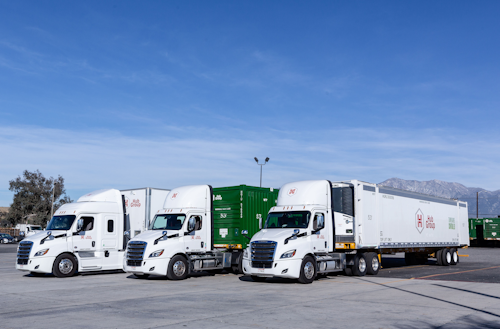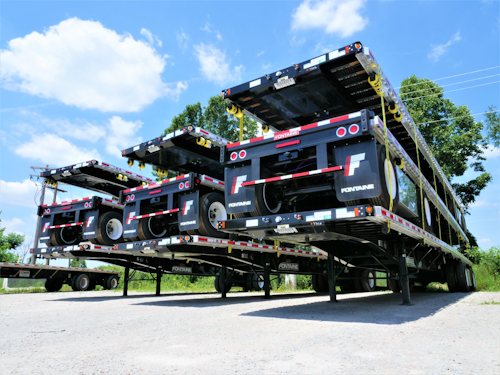Article written by Aaron Huff
Editor’s note: This is the first of a two-part series on how carriers have accelerated their use of technology to be more nimble and responsive during the COVID-19 pandemic. Part 2 will run next week.
The coronavirus pandemic that began in March and continued unabated through the present has been one of the most disruptive events in the history of commercial transportation.
Freight networks that motor carriers had been designing carefully to maximize productivity for their assets and drivers have been upended by shippers closing and reopening facilities. Business practices that once seemed foundational for success, such as working in an office “war room” with team members, have dissipated.
Through the turmoil, motor carriers have become more reliant on critical technologies to respond faster to change and connect with equipment and human assets at deeper levels.
Four of the most critical areas of focus have been managing underutilized assets, responding to customer needs, digitizing the back office and training drivers remotely.
1. Keeping assets moving
Trailer pools always have been a pain point for motor carriers, and the severity has increased during COVID-19. Volatile swings in freight demand have caused more trailers to sit idle at shipper and receiver facilities.
In other industries, asset owners use digital marketplaces to sell their underutilized capacity at a discount, such as Expedia for airlines and Airbnb for lodging. Transportation has a similar marketplace that fleets can use to exchange underutilized trailer capacity for short-term rentals and one-way moves.

vHub’s online community allows carriers to exchange trailer assets with peers for short-term rentals and one-way moves.
However, trailer exchanges are more complicated transactions than buying plane tickets or hotel stays. Fleet owners are concerned about liability for over-the-road repairs, damages, brand protection and timing.
“It is not for the faint of heart,” said Trevor Fridfinnson, chief operating officer for Bison Transport (CCJ Top 250, No. 56). “Those concerns are all real, and no application magically fixes that, but I believe the attitude around [trailer exchanges] is shifting to get the efficiency that is needed in the market.”
The Winnipeg, Manitoba-based truckload carrier has set up trailer exchange agreements with vetted carriers, and some of its past exchange partnerships have turned into business acquisitions, Fridfinnson said. When he heard about vHub’s trailer exchange platform for carriers to arrange and execute transactions for short-term trailer rentals and one-way moves, “we were conceptually very much aligned,” he said.
Finloc, an asset-based equipment lender that owns and leases trailer assets to fleets, developed vHub with “banking rigor” and to operate “by banking standards,” said Francis Roy, vice president of the Montreal-based platform.
Like most truckload carriers, Bison has daily imbalances in freight demand and capacity. It constantly is repositioning trailer assets throughout its network, and Fridfinnson is interested in finding carriers to conduct one-way trailer moves through vHub. Bison also needs to move trailers when buying and retiring them.
Motor carriers that use trailers for one-way moves have the flexibility to pick up and deliver their own loads. The vHub platform gives visibility to trailers available for rental and one-way moves by type (reefer, dry van, flatbed, etc.) and location. The platform also provides details about the owner’s reputation and gives asset owners visibility of important renter information such as insurance coverages and reputation.
Since early March, the number of available trailer assets in vHub has grown from 5,000 to 20,000 units, Roy said. May was the strongest month with 16 companies joining, mostly from the United States.
Roy describes vHub as a community of carriers, private fleets, trailer OEMs and rental companies. To date, the largest portion of available trailers in the platform is supplied by trailer rental companies.
To help facilitate transactions, vHub integrates with telematics systems on trailers to receive locations and mileages automatically to facilitate rental transactions. Drivers can use a mobile app to locate trailers when they are dispatched to pick them up and take pictures of any damage.
The platform manages all the accounting for both parties to have a paperless transaction. Fleets set their own trailer rental rates based on daily-, hourly- or mileage-based use. Renters pay a 10% transaction fee to vHub and a flat $80 fee for one-way moves, Roy said.
Fridfinnson said that with freight markets “as volatile as I’ve ever seen,” Bison is benefiting by using predictive tools to make informed decisions quicker. The company uses Power BI to analyze customer demand data to identify gaps and market opportunities based on where its assets will be coming from and going.
2. Customer responsiveness
Hub Group (CCJ Top 250, No. 22), the nation’s largest intermodal marketing company, has a fleet of 38,000 containers and a nationwide network of terminals located near seaports and rail ramps.

Hub Group uses Orbcomm’s technology on all its 38,000 containers to track critical status information.
In 2013, the Oak Brook, Illinois-based company began to invest in Orbcomm’s GPS-enabled fleet tracking and management platform for its containers to give customers end-to-end shipment visibility and to improve asset utilization and security.
With a fully connected container fleet, Hub Group developed a proprietary platform that combines location data with machine learning and data science technology to give customers real-time shipment visibility. The Orbcomm platform also gives Hub Group container status information for cargo (loaded/empty) and doors (open/closed) to improve asset utilization.
“Being able to provide our customers with true end-to-end visibility on their shipments has been a game-changer,” said Troy Spolum, executive vice president of intermodal for Hub Group. “Operationally, our team has visibility the moment containers are emptied at our customer drop pools and therefore available for use, rather than waiting for status communication, which could be 24 hours later.”
By using door sensors and by geofencing locations with elevated security risks such as certain rail ramps, Hub Group’s operations also get real-time alerts if container doors are opened in unauthorized areas. These alerts can be programmed to be sent directly to law enforcement agencies for immediate investigation.
During COVID-19, knowing the status of containers is critical for Hub Group to respond quickly to the unique “surges and imbalances” experienced across its freight network, Spolum said.
“Supporting our customers’ needs is our top priority, so as customers have been forced to shut down operations and quickly reopen, this data helps us respond immediately,” he said. “We pride ourselves on the ability to support our customers’ recovery efforts.”
Spolum is optimistic about market trends, as West Coast import volumes have been ramping up. “Things are turning around,” he said.
The volatility in freight markets is causing motor carriers of all types to analyze their business activities for cost-saving opportunities in more detail and to use technology to make faster and more informed decisions.
Chris MacDonald, senior vice president and general manager for Orbcomm, said fleet customers have been focused more on solving problems than buying new products during COVID-19.

Remote driver coaching has become the norm with limited in-person contact. Fleets are also using self-coaching driver alerts with systems like Lytx DriveCam.
Fleets are looking more closely at where their assets and drivers have been, and for how long, to minimize detention and keep revenues flowing. Orbcomm’s fleet management products for tractor and trailer assets are designed to allow trailer systems to pass information to tractor-based units via a Bluetooth connection, or through cellular networks, to give drivers real-time visibility of trailer and cargo status information, he said.
By geofencing locations where trailers are stationed, drivers can be notified immediately via an in-cab alert if they connect to the wrong trailer assignment. They also can receive in-cab alerts for trailer load weights, temperatures, tire pressures and malfunctioning brakes and lights.
MacDonald also sees the coronavirus pandemic accelerating a trend for technology providers to collaborate for the end customer’s benefit. Some Orbcomm fleet customers that acquired other fleets that were using competitive telematics products are having the asset-tracking and status data from the other products integrated with their Orbcomm web portal to manage all assets through a single platform, he said.
3. Digitizing workflow
As motor carriers have transitioned to remote work environments, the need to keep production levels high in front- and back-office functions has elevated the value of certain technologies.
JLE Industries, a Pittsburgh-based flatbed carrier with more than 300 power units, has been using technology to digitize its workflow of data and documents in the order-to-cash lifecycle for loads.

Starting with one truck in 2015, JLE Industries has grown to 300 tractors with a specialty in flatbed transportation.
The company uses Vector’s cloud-based document management platform, which has been useful when customers send orders by email with attached documents.
The Vector platform has optical character recognition (OCR) technology that extracts data from emails and documents to create electronic load tenders that flow directly into JLE’s transportation management software (TMS) system. This process eliminates time for entering orders that otherwise would take five to 10 minutes per load, said Tim Tran, vice president of systems and technology for JLE.
The orders are accepted by load planners in the TMS and matched with capacity. Once a load is delivered, drivers capture an image of a bill of lading using Vector’s mobile app. The OCR technology extracts data from the image and compares it to the order information to flag any errors for the invoicing process.
JLE currently is testing a new capability from Vector. If the information on an order and a delivery document matches, users in the billing department simply click “accept” to complete the invoice. A single clerk could bill 100 loads in five minutes, Tran said. Overall, JLE bills about 1,000 loads a week.
Another tool JLE is using to boost production is Zoom videoconferencing. The operations department has a staff of 30 people that work in a virtual war room organized into different sectors. By simulating a real-time office environment, JLE has been able to make decisions and execute faster, Tran said.
Zoom works side-by-side with JLE’s internal system called Driver OS, which gives load planners and fleet managers everything they need to do their jobs. The system also sends drivers recommended route plans for each load that include rest and fuel stops.
The route plans are customized for each driver based on their own preferences and habits by using predictive analytics that “learn” driver behaviors, Tran said.
4. Remote driver coaching
A remote work environment also has made it necessary for companies to conduct remote driver coaching and rely on technology to help drivers self-correct risky behaviors.
Lytx, a video-based telematics provider, has seen more of its customers activating in-cab alerts when the camera vision-enabled platform detects drivers using a handheld, rolling through a stop sign or not wearing a seatbelt. The alerts give drivers a chance to self-correct before the events are reported to management for review, said Del Lisk, vice president of safety services for Lytx.
Fleets that use the Lytx DriveCam program also are letting drivers review lower-risk incidents by themselves from any mobile device, such as not wearing a seatbelt. The self-coaching tool sends drivers an email alert with a link to access and resolve an event video using an online portal.
Lisk said another capability fleets and drivers are using is live streaming video from the Lytx system to get management involved to resolve certain situations that drivers are experiencing, such as safety issues at customer locations or safety hotspots on routes.
Faced with an unprecedented timetable of volatile business conditions and limited person-to-person contact with office workers and drivers, fleet managers increasingly are leaning on technology to navigate through a growing set of challenges.
Original Source: https://www.ccjdigital.com/carriers-technology-strategies-emerge-stronger-coronavirus/

